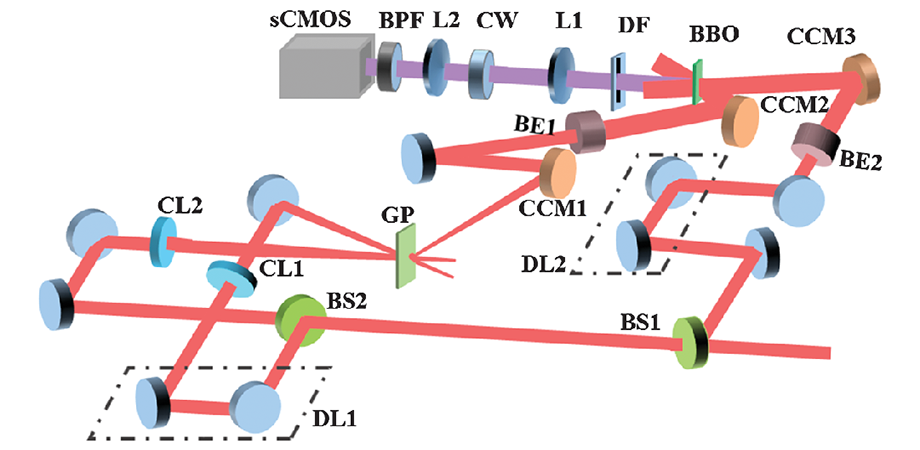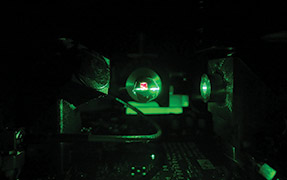High-Contrast Measurement Technique Reveals Hidden Ultrashort Laser Pulses

To understand materials, it is not enough to observe, sometimes you have to give them a sharp prod and see how they respond. The best prod that we have comes in the form of ultrashort laser pulses. But that relies on having highly accurate knowledge of the laser pulse, which is put into theoretical models of the material response.
However, high-intensity ultrashort laser pulses can include pre- and post-pulses that make understanding a material's response to a laser pulse much harder to interpret. A pre-pulse that is a billion times weaker still has enough energy to initiate physical processes, which changes the way that matter reacts to the main pulse. Identifying the influence of pre- and post-pulses is critical to understanding how matter reacts to high-intensity laser pulses. Removing pre- and post-pulses is even better.
Identifying and removing pre- and post-pulses is difficult, because the more intense and shorter a laser pulse becomes, the harder they are to detect. To put it in perspective, it is a bit like searching for mice in a field of stampeding elephants: the thundering mass makes it impossible to find the tiny details.
Why is this the case? Ultrashort pulses are often characterized by autocorrelation, where the laser pulse is used to measure itself via a nonlinear interaction in material (like a glass or a crystal). One consequence of autocorrelation being nonlinear is that strong pulses produce a stronger output relative to weaker pulses: essentially, weak pre- and post-pulses get even weaker after autocorrelation. When combined with the limited dynamic range (the range between lowest and highest possible intensity that can be measured) of optical sensors, weak pulses may get lost in the noise.
This is the issue that is addressed by Wang and colleagues from the Chinese Academy of Sciences. They produced an autocorrelator that can detect pre- and post-pulses that are 10 billion times weaker than the main pulse. This will eventually allow researchers to study how matter reacts to light with cleaner high-intensity laser pulses.
Autocorrelators find pulse energy
To understand their approach, we need to briefly delve into the world of autocorrelation. To autocorrelate an ultrashort pulse, the pulse is split into two and recombined in a material. The recombination is such that one copy of the pulse is delayed with respect to the other. As that delay varies, the overlap of the two pulses in space and time changes. When the overlap is perfect, the autocorrelation output is strong, while when the pulses do not overlap, the output is weak. Hence, it is possible to map out where most of the energy is stored in a pulse by measuring the autocorrelator output as a function of the overlap between pulses.
To increase the dynamic range of autocorrelation, Wang and colleagues combine two autocorrelators. The incoming pulse is split into three. Two of the pulses are shot into a plate of glass, where their overlap generates a new pulse of light, corresponding to a third-order autocorrelation of the input laser pulse. Third-order autocorrelators are quite common. But, in the standard implementation, the two pulses travel at different speeds in the plate of glass. To prevent this from influencing the autocorrelation measurement, the glass plate has to be very thin, which means that the generated light pulse is very weak (the strength of the pulse is proportional to the length of glass in which the autocorrelation is performed). Wang and colleagues' efforts focused on making the pulses travel at the same speed, so the plate of glass can be thicker and the generated pulse stronger.
The new light pulse is then sent into a second autocorrelator, where it is overlapped with the last copy of the original pulse. This second autocorrelation step is more efficient than the first, meaning that it also produces strong output light pulses. The combination of the two autocorrelators results in a fourth-order autocorrelation of the original pulse.
Measure once, analyze twice
Because the output is so strong, the researcher can then divide the output into weak (about 1%) and bright pulses. The weak pulse is used to analyze the main pulse, but pre- and post-pulses don't show up there. The bright pulse is searched for pre- and post-pulses, which show up nicely, allowing researchers to tune the laser to eliminate them.
The setup is not perfect, however. For instance, the bright pulse could still damage the detector if not attenuated correctly. The current setup only allows for a step-like attenuation to protect the detector, while their results show that this is not sufficient to characterize very strong pulses. The researchers have indicated that the next version will likely include a more flexible attenuation setup.
Read the original research article in Advanced Photonics.
| Enjoy this article? Get similar news in your inbox |
|



